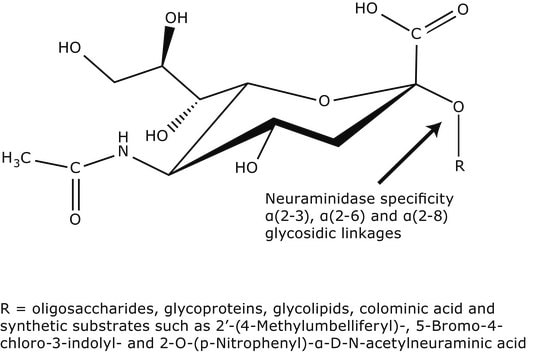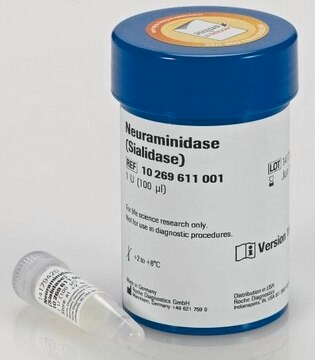N2876
Neuraminidase from Clostridium perfringens (C. welchii)
Suitable for manufacturing of diagnostic kits and reagents, Type V, lyophilized powder
Sinonimo/i:
Acyl-neuraminyl Hydrolase, Receptor-destroying enzyme, Sialidase
About This Item
Prodotti consigliati
Livello qualitativo
Tipo
Type V
Forma fisica
lyophilized powder
Attività specifica
≥0.1 units/mg solid (using mucin)
≥1.3 units/mg solid (using 4MU-NANA)
applicazioni
diagnostic assay manufacturing
Attività estranea
Protease and NAN-aldolase, present
Condizioni di spedizione
dry ice
Temperatura di conservazione
−20°C
Informazioni sul gene
Clostridium perfringens str. 13 ... nanI(988807)
Cerchi prodotti simili? Visita Guida al confronto tra prodotti
Descrizione generale
Applicazioni
Azioni biochim/fisiol
Definizione di unità
One unit will hydrolyze 1.0 micromole of 2′-(4-methylumbelliferyl)-a-D-N-actetylneuraminic acid per minute at pH 5.0 at 37 °C (using 4MU-NANA as a substrate)
Nota sulla preparazione
Risultati analitici
Avvertenze
Danger
Indicazioni di pericolo
Consigli di prudenza
Classi di pericolo
Resp. Sens. 1
Codice della classe di stoccaggio
11 - Combustible Solids
Classe di pericolosità dell'acqua (WGK)
WGK 1
Punto d’infiammabilità (°F)
Not applicable
Punto d’infiammabilità (°C)
Not applicable
Dispositivi di protezione individuale
Eyeshields, Gloves, type N95 (US)
Certificati d'analisi (COA)
Cerca il Certificati d'analisi (COA) digitando il numero di lotto/batch corrispondente. I numeri di lotto o di batch sono stampati sull'etichetta dei prodotti dopo la parola ‘Lotto’ o ‘Batch’.
Possiedi già questo prodotto?
I documenti relativi ai prodotti acquistati recentemente sono disponibili nell’Archivio dei documenti.
I clienti hanno visto anche
Protocolli
Il team dei nostri ricercatori vanta grande esperienza in tutte le aree della ricerca quali Life Science, scienza dei materiali, sintesi chimica, cromatografia, discipline analitiche, ecc..
Contatta l'Assistenza Tecnica.











